Genre: Strategy Developer: Imagitec Designs Inc. Publisher: GameTek Players: 1 Released: 1992
You could almost call it a tradition. Whenever a game is released that is popular and even a little bit original, it is only a matter of time until other developers leap and create a knock-off title based on the same idea, albeit with a slightly different clothing. Just look at the masses of Street Fighter II clones out there. One of those games was Lemmings. Originally released in 1991, this game created a new sub-genre of puzzle games: Suicidal little creatures must be led to safety by empowering them with certain abilities at just the right moment, necessitating foresight, logic and timing on the player’s side. It was a huge hit and saw ports to almost every single platform imaginable. Naturally, it didn’t take long for the first copycats to arrive, to varying success. One of the better entries into this library is the originally titled The Humans, published by GameTek.
In true knock-off tradition, The Humans basically takes the formula that made Lemmings a success (lead a couple of cute but dense little creatures to safety over a huge number of levels with increasing difficulty), gives it a slight twist and tacks on whatever fad was popular at the time in order to give it some kind of distinguishing element. Seeing that the game was created in the early nineties, the gimmick of choice was – what else – cavemen and dinosaurs (there truly was no way of escaping this trend in the early nineties, wasn’t there?). As far as gimmicky copycat titles go, however, this one actually manages to stand on its own… well, kinda.
Now to be fair, this game has a few things going for it, and it isn’t all too close a copy of the original premise. Apart from the setting (cavemen instead of little green-haired creatures), The Humans differs from Lemmings in two main areas. First, whereas Lemmings gives you a different number of creatures in each level, and you must save a certain number of them in order to succeed, The Humans starts you out with twelve cavemen, using four to seven of them in each level. You only need to keep one of them alive in order to finish each stage, but each death will take one of your overall “tribe” away. Once the overall number of humans you have at your disposal drops below the number of humans needed to succeed in a particular level, it’s game over. You can raise the number of your tribe members by saving captured humans throughout certain levels, by the way. You have eighty levels to complete, so there is a long way to go until you see the ending of the game.
The other difference: Unlike in Lemmings, your humans don’t run blindly to their doom… not right away anyway. You get to control all of your humans individually. At first, they can only climb ladders or stack upon one another in order to reach higher platforms. Some levels contain tools the humans can use, which enables a number of additional abilities. There are four basic tools which are revealed over time: The spear, the torch, the rope and the wheel. In some stages you have a shaman at your disposal, who can sacrifice a tribe member in exchange for one of these four items. Before you do that, you should carefully plan which you absolutely need, because once summoned, the creature is lost forever. With a spear, for example, a human can jump, he can attack while standing still, or he can throw it in an arc – useful for attacking or passing the tool back to a friend. So yeah, humans can actively fight against enemies (like other tribes or dinosaurs) in this game. Be careful not to accidentally kill one of your own tribe members by throwing a spear into him by accident, though.
Unfortunately, that is easier said than done, as the controls are a bit awkward. They are simple in premise: A lets you select your next human to control, B performs the selected action, and C lets you cycle through the abilities the tribe member has at hand. Certain actions, like making a jump or throwing an item, need to be charged up first. One press of the B button readies the human, pressing and then holding the button after that fills a power bar, and releasing it performs the ability. However, the game reacts very sensitively to button presses. This can be a bad thing. For example, if you want to charge up a jump. If the power bar is too low, you might not make the distance and fall to your death. Unfortunately, the game sometimes registers another button press immediately after you got ready to line up a jump. I lost quite a number of tribe members that fell to their death because the game thought I had let go of the B button already when I wasn’t even intending to charge up the jump.
The game design at some points leads to a few unfortunate situations that make the level unbeatable. For instance, if you have only one tool at your disposal and you need it to throw across a gap, but the throw ends up too short, you can immediately restart the stage; you won’t get a second try. This can be frustrating when you can see the needed item just in front of you but are unable to reach it after you messed up another throw, or your only available human forgot to take an item with him and dropped down a small ledge, still alive but unable to get back up.
Unlike the home computer versions of the game, the Genesis incarnation allows you to choose whether you’d like to hear sound effects or background music during the game. Don’t let the chopped up, endlessly looping main menu theme fool you. The soundtrack is decent and even preferable to just having a couple of sound effects that don’t amount to much more than beeps or thuds. I don’t understand why it wasn’t possible to choose both, though. By the way, for some reason the Genesis version uses the same levels as the home computers, but not the same level order. The progress in difficulty feels odd, and the game isn’t really getting increasingly difficult. Harder stages are at times followed up by easier ones. Again, I can’t come up with an idea why that decision was made; it just feels strange.
The graphics are cute but unremarkable. The game uses only a small variety of different background, but it’s enough to avoid too much repetition. Sadly, you always just get to see a small area of the level, but the screen centered on your selected tribe member. Choose a new one, and the view swerves over to him, which can get a bit nauseating. The ability to call up a short overview or at least a map showing the level layout would have helped. Even Lemmings had a (very small) overview and allowed you to explore the screen on your own. The Humans lacks those features, and they are sadly missed. Instead, you get a few comics-style cut scenes in between levels, which are, as I said before, cute but unremarkable.
Maybe it isn’t fair to call up so many comparisons to Psygnosis’ classic puzzle game, but it’s hard to deny that The Humans tried to conjure a similar feeling and appeal to a similar audience. And I admit, for a while I had a little fun with the chubby little creatures. In the long run the game isn’t as entertaining as its role model. Still, if you are a fan of the genre, it’s a great way to pass a few hours.
SCORE: 6 out of 10


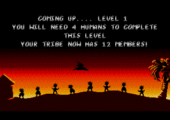
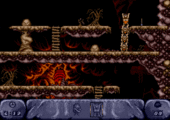
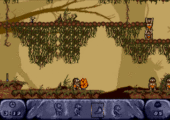
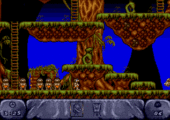
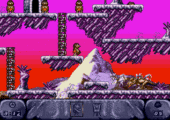
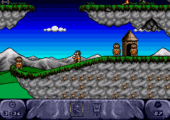
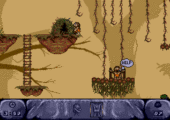
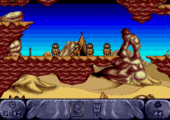
Recent Comments